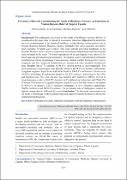| dc.description.abstract | Background: The pathogenic bacterium on the hands of healthcare workers (HCWs) is considered as the main route of spread of nosocomial infections. Objectives:To determine bacterial contamination of the hands of healthcare workersduring routine patient care in Masaka Regional Referral Hospital, Uganda. Methods: This cross-sectional, descriptive study included 70 health care workers, who were actively providing healthcare in the hospital. Doctors, nurses, midwives,laboratory technicians, and pharmacistsof the hospital were included in the study. The hand impressions of the participants were taken on 5% blood agar and processed as per guidelines. The criteria used for identification of bacteria werebased on colony morphology, Gram staining, catalase test (for Gram-positive cocci), coagulase test (for suspected Staphylococcus aureus) and other standard biochemical tests. Results: Out of 70 samples, 62(88.6)% showed growth of microorganisms. The most commonly isolated genus was Bacillus found in 46(74.2%) of isolates, followed by Coagulase negative Staphylococcus(CoNS) found in 39(62.9%) of isolates, Micrococcus 18(29%) of isolates, Pseudomonas found in 13(21%) isolates, Acinetobacter 9(14.5%) and Staphylococus 7(11.3%). Bacillus was found in all 5 midwives (100%), 3(75%) of drug dispensary workers, 9(69.2%) doctors, 3(60%) laboratory technicians and 25(64.1%) of nurses. Prevalence of Coagulase negative Staphylococcus was also found to be highest in 9(69.2%) of doctors, 2(40%) laboratory attendants, 4(10%) laboratory technicians, 3(60%) midwives and 20(51,3%) nurses. The prevalence rate of pathogenic bacteria is highest among doctors followed by nurses.Conclusion: The bacterial contamination on the hands of healthcare workers remains high and measures need to be taken to effectively implement hand hygiene. | en_US |

